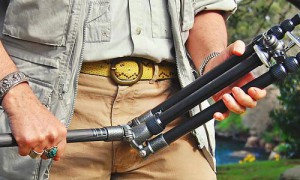Using a tripod is the best way to get rid of blurry photos due to camera shake. Find out about tripod types, how to choose the best one for you and using it with these tips from Tony Page of Travel Signposts Photo.
 “Hi, I’m Tony Page from Travel Signposts Photo, and in furtherance of our continuing war against the Curse of Blurry Photographs today we’re going to talk about that accessory we all hate but we wish we had with us when we haven’t got it: yes, the tripod.
“Hi, I’m Tony Page from Travel Signposts Photo, and in furtherance of our continuing war against the Curse of Blurry Photographs today we’re going to talk about that accessory we all hate but we wish we had with us when we haven’t got it: yes, the tripod.
You need a tripod
Now there are lots of tripods, different types made out of steel, magnesium, titanium and now carbon fibre; and all have one thing in common: they are a nuisance to carry around. But they’re very useful, in fact, essential if we want to take certain type of photographs. If you need to take photographs with long exposures there really is very little substitute. There are substitutes, we’ll talk about those later, but first of all let’s look at the tripods.
Types of tripod
Now this one is my trusty Gitzo: it’s made of steel, I believe and weighs about 3 kg. I carried it around for a long time as a travel journalist, still do occasionally, but it’s quite heavy, although it’s very useful, especially for beating off marauding thugs in downtown Manila or the occasional pack of dingoes in outback Australia. However if you’re on holiday it’s not the kind of thing you want to be carrying around with you all the while.
This one is a carbon fibre tripod. This is what I use now, it weighs about a kilo, and and you can have different heads on it, as you can with all my tripods. Of course it’s a Gitzo, and carbon fibre, so yes, it’s expensive, but you can get plenty of cheaper tripods that will do okay. But beware, you know that cheap tripods are very often cheaper for a reason.
How to test out your tripod
Here is a good way of testing out your tripod. Put it up to its maximum height or at least to that height at which you’re most likely to use it. Now, put your hand on top of it, you don’t have to have the camera on it, put your hand on top of it and move it backwards and forwards. The tripod should not move all and in fact that’s the really amazing thing about these carbon fibre ones, you know. When I first got one I thought ‘uh-oh, these legs are very thin, they’re going to be flexible, it’s going to be a bit shaky’. It’s not, it’s amazing, if you put your hand on top of it you can’t move it at all from side to side and the rigidity is astonishing, and that’s what you’re paying for.
So that’s the first thing to test when you’ve got your smaller or cheaper tripods: test the stability. It’s absolutely no use whatsoever to get one of those tripods that wave about in the wind or quiver whenever you touch them when there’s a camera on top of it. And don’t forget that if you’ve got a really heavy camera you’re going to need a more rigid if not heavier tripod.
Strained wrists or trapped fingers?
The next thing to check about tripods is how they go up and down. Now you’ve got a choice here, generally one of two, trapped fingers or strained wrists. Just joking, but I tend to like the twist method, you can see it on this Gitzo here. Others swear by the clips. I find those clips tend to catch on things and sometimes they get a bit too much dirt in them. But you pays your money and you takes your choice. Another thing to look out for, and you’re seeing more of this now, are the tripods where the legs can reverse for packing, that can be helpful, and another thing is to make sure your tripod legs really go out quite flat because it’s surprising how often you can get a good shot from a very low viewpoint. On some tripods you get to 45° and you’re stuck, so give that a go.
Don’t forget a cable release
Okay, that’s about it for tripods, except to remind you that one thing you should always have with you if you’ve got a tripod and that’s a cable release. There’s not much point in having a tripod and then hitting your finger on the release and giving it a bit of vibration that way. So do get a cable release, they cost little and they don’t take up much space. You can use a timer, of course, but a cable release gives you more precision, and when you want to take that night shot of that car coming past you just at the right time a cable release is the only way to go.
That’s it for tripods, next time: Monopods. Until then this is Tony Page from Travel Signposts wishing you: Good Shooting!”
Your Turn: Do you have any advice you would like to share? What tips would you like to add? Please comment below.
 Guerrilla Travel Photography eBook
Guerrilla Travel Photography eBook Take Better Digital Photos eBook
Take Better Digital Photos eBook
Leave a Reply